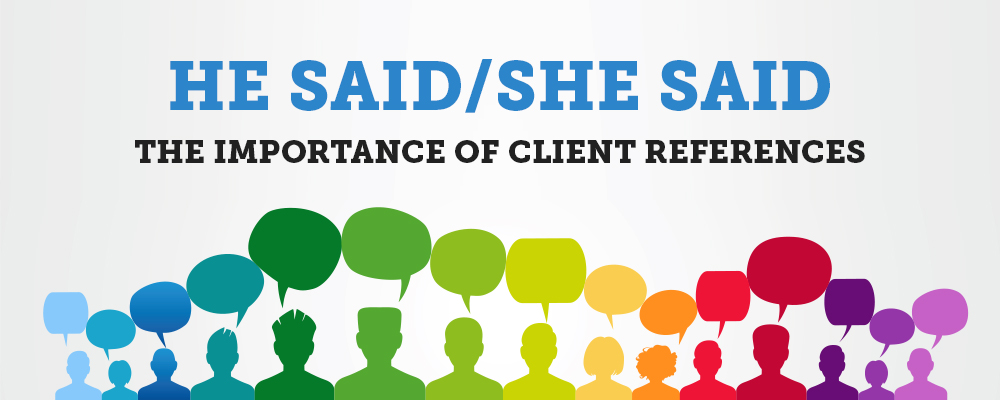He Said/She Said
The importance of client references
The elusive client reference is often coveted as the Holy Grail in B2B Marketing. And with good reason, too; it’s one thing to tell your prospective clients just how good you are, but it’s quite another for them to hear it in client references from already satisfied customers whom they respect and whose stories resonate. Put simply, other people telling your brand’s story is a marketing asset like no other.
With the right brand names promoting you, potential clients are reassured and encouraged. But it’s not just about getting the biggest brands in the world to shout about you (although there’s nothing wrong with that!). The client references you should focus on getting are:
- those that you know have had the best possible experience and demonstrable return on investment (ROI) as a result of working with you (and your brand);
- those that are operating in the markets that you want to dominate.
By focussing first on these two areas, you’ll be spending your efforts on getting hold of references that are not only realistic, but which will work best for your brand and business development objectives.
Computer says “no”
It’s not always easy to get ‘official’ references – even from customers who would sing your praises until they were blue in the face, given half the chance. All too often corporate red tape can get in the way, and pesky back office teams can put the kibosh on that killer testimonial. We have a couple of tips for combatting this:
- Ask early! And we mean early. Make your reference process part of your formal proposal to your client if you can. You could even consider incentivising the reference by offering clients a better deal in exchange for an honest review. Make it clear that it’s the time to carry out a reference that is incentivised, and not a glowing review – it’s about getting more honest references, not buying positive results!
- Don’t leave it. If you’re not comfy with talking about references before the client has even signed on the dotted line, then at least ask them AS SOON AS it would be reasonable after receiving your product or service (obviously this varies depending on the product/service in question). If you catch them at an early juncture, you’re more likely to get an engaged (and positive) response. Leave it too long and you may have been forgotten – your request will certainly fall lower on their to-do list.
You’ll get a lot more out of a two-way conversation as you can dig deeper into real areas of interest
- Make it easy; don’t bog down your busy clientele with reams of questions in a word document. Provide online links with “out of five” scales, positive/negative/neutral questions and straightforward comments boxes. Better yet, actually take the time to talk to your clients in a real-life conversation, whether face to face or on the phone. Let them know that you’re recording your chat and will transcribe and write it up into your preferred format (testimonial, online/printed case study etc.) before requesting their comments and suggestions. You’ll get a lot more out of a two-way conversation as you can dig deeper into real areas of interest and guide soundbites that you know will provide maximum impact. Plus, people won’t see it as a chore to have a chat!
- Get sign off (and keep hold of it!). This is critical. Whether it’s a simple one-sentence testimonial or a multiple-page case study, if you don’t get their sign off, your hard work could all be for nothing. If you’re naming the client then it’s their reputation on the line as much as yours. Would you be happy to find out that someone has quoted you without letting you know? Always save a copy of whatever sign off method you use (whether that’s a formally signed document or a written agreement in an email) in case the “guys from legal” get on the phone for a moan.
- If in doubt, keep it informal. If you do find that you’re constantly coming up against the dreaded red tape, consider a more informal feedback process. It might not be the same as a singing-your-praises case study, but a simple anonymous feedback form (or even just a single click positive/negative/neutral rating) is certainly a step up from nothing at all. It puts the corporate bigwigs minds at ease that names aren’t being named, and you could even consider utilising a third party ratings and reviews partner to help promote the legitimacy and transparency of the reviews received.
- A picture paints a thousand words. Written client testimonials are great and, as we’ve discussed above, must ideally always be accredited to a real life person from that grateful organisation: their name, title and company. It’s even stronger, however, to accompany these great words with a photo of the client and / or their company’s logo (cue red-tape, again). Of course, testimonials are hard enough to get, let alone a close-up picture, but if you can pull this off it really adds credibility to the testimonial. Believe it or not, prospects can be cynical and may even accuse you of making the testimonials up yourself! The pinnacle of client references, especially for use in a presentation or on your website, is a video testimonial. Getting a client to wax lyrical about you and your brand on camera is gold dust and incredibly powerful. Technically, you don’t need a three-man camera crew to achieve this; most smart phones and a quiet environment will make a perfectly decent recording. And be sure to edit down the piece to remove any “errs” and “umms”, covering the cuts with the classic ‘hands close-up’.
In summary…
As with all marketing, it’s worth putting yourself in the shoes of your prospects. Who would you trust more – a brand that talks a good game but has no client references, or one teeming with testimonials and case studies from already satisfied clients? Make client references a part of your marketing strategy, and do it sooner rather than later.
Remember, too, that people are more likely to share negative experiences, particularly on social media platforms (we’ll get to how to deal with that in another post!); so whatever you can do to counter-balance this and improve your brand’s outwardly-facing reputation with positive sentiment, the better.
Of course, if you need a hand with where to start, we always recommend starting at… Square1.
Here’s some of ours!








